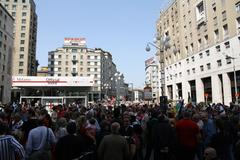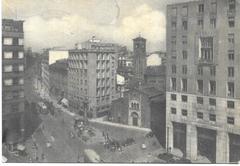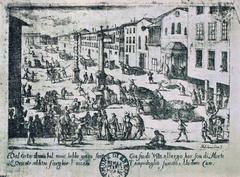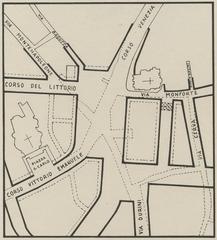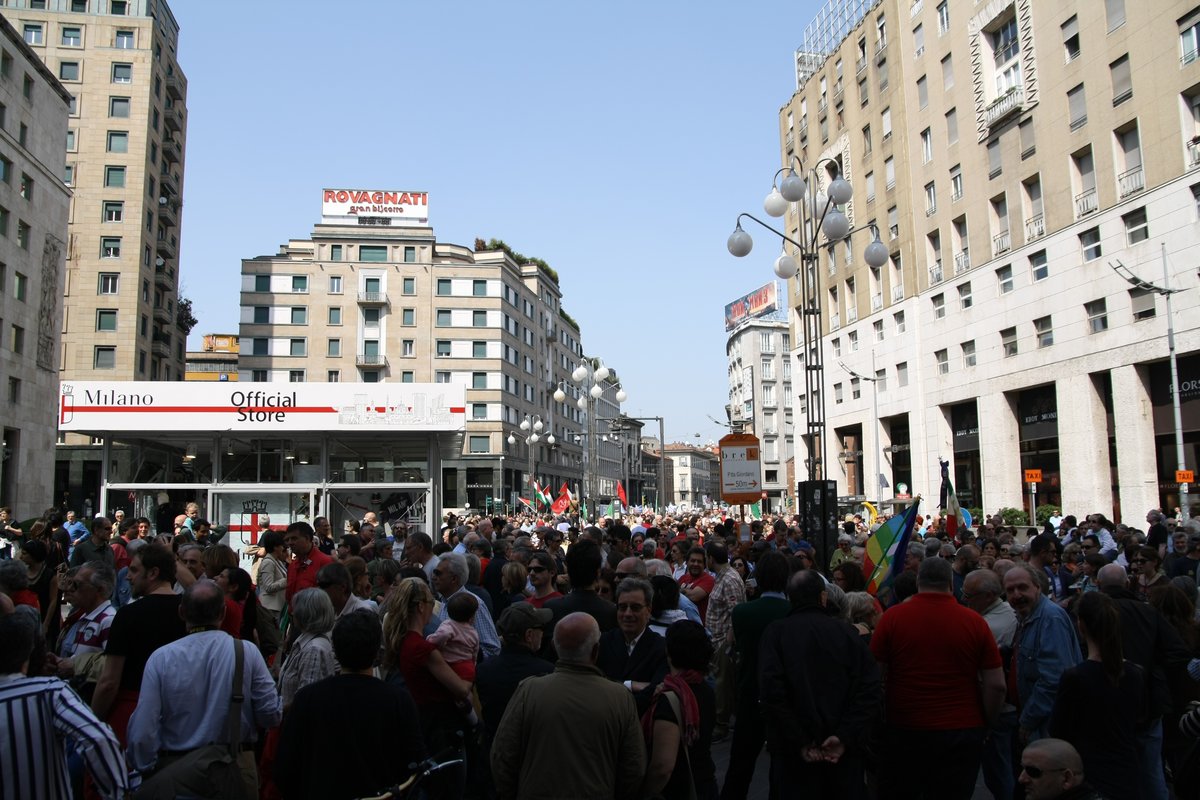
Piazza San Babila Milan: Visiting Hours, Tickets, and Nearby Attractions
Date: 15/06/2025
Introduction
Piazza San Babila stands as one of Milan’s most iconic and vibrant urban spaces, offering visitors a dynamic intersection of history, architecture, and culture. Located at the crossroads of major city thoroughfares—Corso Vittorio Emanuele II, Corso Europa, Corso Venezia, and Corso Monforte—this square has evolved over centuries from medieval origins around the Basilica di San Babila into a contemporary hub at the heart of Milan. The piazza seamlessly blends Roman, medieval, and rationalist elements, making it both a historical anchor and a modern gathering place.
This comprehensive guide details everything you need to plan your visit: Piazza San Babila visiting hours, ticket information, accessibility, travel tips, and highlights of nearby attractions such as the Duomo di Milano, Teatro alla Scala, and Milan’s fashion districts. Whether you’re a history enthusiast, architecture lover, or simply looking to experience the pulse of Milanese life, Piazza San Babila is a must-visit destination.
For official details and further insights, consult resources like Milanodavedere, Italia.it, and Lucadea.
Table of Contents
- Introduction
- Historical Overview
- Architectural Features
- Cultural and Social Significance
- Visiting Information
- Nearby Attractions
- Dining, Shopping, and Local Experiences
- Frequently Asked Questions (FAQ)
- Conclusion
- References
Historical Overview
Piazza San Babila’s origins are deeply intertwined with the adjacent Basilica di San Babila, which dates back to the late 11th century, built atop the remains of a Roman temple. The surrounding area developed as an important gathering and spiritual site, with the basilica serving as a focal point for religious and civic life (Milanodavedere).
The square underwent dramatic transformation in the 20th century, particularly under Fascist urban planning between 1931 and 1948. Historic buildings like the Venetian Houses were demolished to make way for rationalist structures, reflecting Milan’s modernization and the regime’s penchant for monumental public spaces (Italia.it; Wikipedia). Today, Piazza San Babila embodies Milan’s ongoing dialogue between its ancient roots and contemporary ambitions.
Architectural Features
Basilica di San Babila
The basilica is the square’s defining monument, featuring a neo-Romanesque façade designed by Paolo Cesa Bianchi in the late 19th century. Key features include rounded arches, a central rose window, and a golden mosaic depicting Christ. Inside, the church offers a harmonious nave, elegant chapels, and noteworthy artworks such as Ludovico Pogliaghi’s altarpiece and Luigi Cavenaghi’s frescoes (Milanese Churches; Italia.it).
Rationalist and Modernist Buildings
The 1930s and 1940s introduced rationalist landmarks like Palazzo del Toro (by Emilio Lancia) and Torre Snia Viscosa (Milan’s first skyscraper, by Alessandro Rimini), both exemplifying the era’s emphasis on functional form and geometric clarity. These buildings frame the square, creating a compelling contrast with the basilica’s historic presence (Elle Decor; Italia.it).
Urban Design
The square’s open, pedestrian-friendly layout encourages social interaction and public events, while fountains and small monuments add visual interest without overwhelming the space (Divento).
Cultural and Social Significance
Piazza San Babila’s central location has long made it a social and commercial crossroads. In addition to its religious importance, the square became a center for Milan’s “Milano da Bere” lifestyle in the 1980s, with upscale cafés and boutiques embodying Milanese elegance (Milanodavedere). Today, it hosts seasonal markets, open-air concerts, design events, and interactive installations such as the Fiorucci Digital Pop-Up.
Visiting Information
Visiting Hours
- Piazza San Babila: Open 24/7 as a public space.
- Basilica di San Babila: Typically open from 9:00 AM to 12:30 PM and 3:30 PM to 7:00 PM. Hours may vary on holidays—check the basilica’s official site or local tourist information for up-to-date details.
Tickets
- Entry to both the piazza and basilica is free.
- Donations are welcomed at the basilica.
- Special exhibitions or guided tours within the church may require tickets.
Accessibility
- The square and basilica are wheelchair accessible, with ramps and accessible metro stations (Lines M1 and M4).
- Urban renewal has improved pedestrian pathways and crossings for visitors with mobility needs.
How to Get There
- Metro: San Babila station (M1 Red and M4 Blue lines) is located directly beneath the piazza.
- Tram and Bus: Multiple lines serve the area.
- Car: Nearby parking garages are available, but public transit is recommended due to traffic restrictions.
Guided Tours and Events
- Guided walking tours often include Piazza San Babila as a key stop, covering its history and architectural highlights.
- The square hosts cultural events and seasonal markets—check Official Milan Tourism Website for current listings.
Photography Tips
- Mornings and late afternoons provide optimal light for photographing the basilica and rationalist buildings.
- The juxtaposition of old and new architecture offers unique photographic opportunities.
Nearby Attractions
- Duomo di Milano: A Gothic masterpiece, 5–7 minutes on foot (Duomo di Milano).
- Galleria Vittorio Emanuele II: Historic shopping arcade, 5 minutes away (Galleria Vittorio Emanuele II).
- Teatro alla Scala: Renowned opera house, about 10 minutes’ walk (Teatro alla Scala).
- Quadrilatero della Moda: Milan’s luxury fashion district, including Via Montenapoleone and Via della Spiga (Via Montenapoleone).
- Durini Design District: A hub for interior and industrial design enthusiasts.
- Fontana di Piazza San Babila: Modern fountain by Luigi Caccia Dominioni (Fontana di Piazza San Babila).
- Torre Velasca: A striking post-war rationalist tower, 15 minutes’ walk away (Lampoon Magazine).
Dining, Shopping, and Local Experiences
- Dining: From classic cafés in the Galleria to local trattorias and gelaterias, the area offers diverse culinary options.
- Shopping: Explore luxury boutiques in the Quadrilatero della Moda and design showrooms in Durini Design District.
- Cultural Events: Seasonal concerts, art installations, and fashion events frequently animate the square.
Frequently Asked Questions (FAQ)
Q: Are there entrance fees for Piazza San Babila or the basilica?
A: No, both are free to enter; donations are appreciated at the basilica.
Q: What are the basilica’s opening hours?
A: Generally 9:00 AM–12:30 PM and 3:30 PM–7:00 PM, but check ahead for holiday hours.
Q: Is Piazza San Babila accessible for visitors with disabilities?
A: Yes, with ramps, accessible metro stations, and smooth pathways.
Q: How do I get to Piazza San Babila by public transport?
A: Take the M1 or M4 metro lines to San Babila station; trams and buses are also available.
Q: What is the best time to visit?
A: May to early July and September to October offer pleasant weather and fewer crowds.
Q: Are guided tours available?
A: Yes, several local operators offer walking tours including the piazza and nearby highlights.
Conclusion
Piazza San Babila encapsulates Milan’s layered history, architectural diversity, and contemporary energy. As a freely accessible public space, it offers a compelling starting point for exploring the city’s iconic landmarks, shopping districts, and cultural events. With its blend of Roman, medieval, and rationalist elements, the square invites visitors to witness the ongoing dialogue between tradition and innovation that defines Milan.
For the best experience, check current basilica opening hours, participate in a guided tour, and explore nearby attractions. The square’s accessibility and central location ensure an inclusive and memorable visit for all.
For more travel tips, personalized itineraries, and updated event information, download the Audiala app and connect with us on social media. Enhance your Milan adventure with expert insights and exclusive content.
References
- Milanodavedere – Piazza San Babila: Visiting Hours, Tickets, History & Travel Tips
- Lucadea – Discover Piazza San Babila: Visiting Hours, Tickets, and Cultural Significance in Milan
- Italia.it – Piazza San Babila History and Architecture
- Elle Decor – Piazza San Babila Milan: Visiting Hours, Tickets, and Architectural Highlights
- Milanese Churches – Basilica di San Babila
- Divento – Piazza San Babila, Milan
- Duomo di Milano (Official)
- Galleria Vittorio Emanuele II (YesMilano)
- Teatro alla Scala (Official)
- Via Montenapoleone (YesMilano)
- Fontana di Piazza San Babila (Triphobo)
- Fiorucci Digital Pop-Up (Designboom)
- Lampoon Magazine – Torre Velasca
